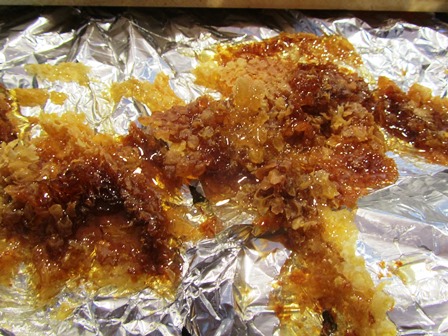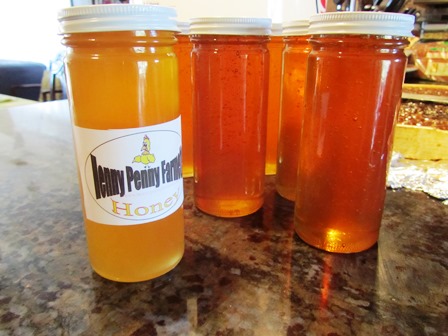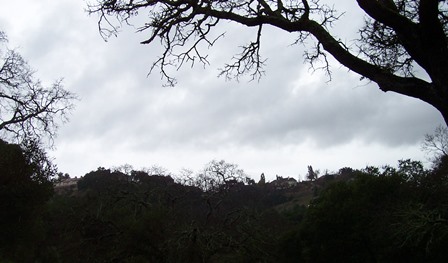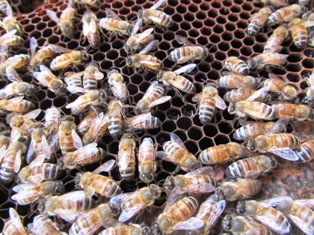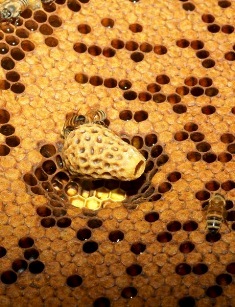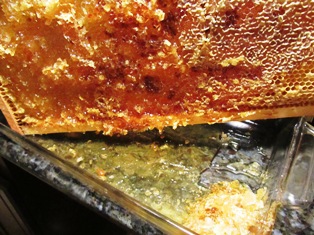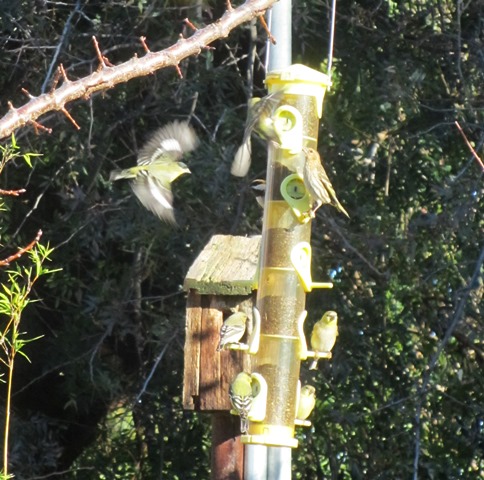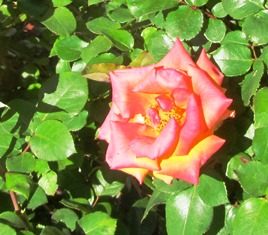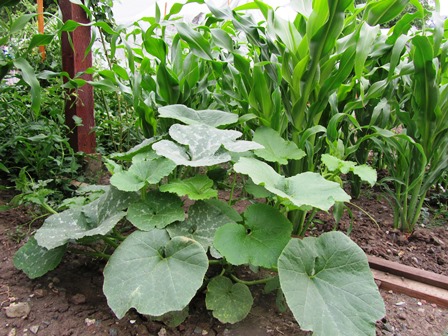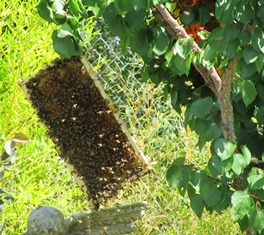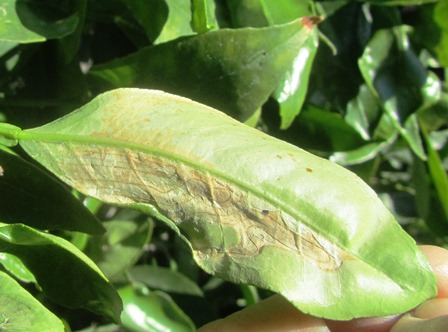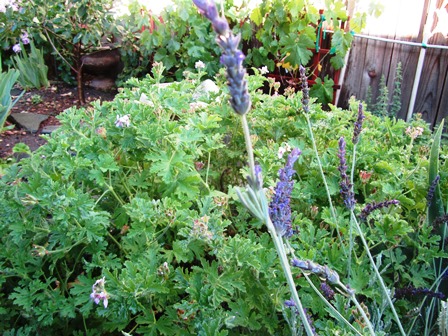Archive for January, 2015
Uncapping, Draining, and Straining a Frame of Honey
I have frames of honey wrapped in foil in my kitchen freezer. These frames haven’t yet been uncapped, drained, and strained for bottling.
Since the weather on the farmette has turned springlike, I can’t put this chore off any longer. Those frames have to come out of the freezer. They’re from late October. I’d wrapped them in aluminum foil and froze them until I could find time to work with them.
Once a frame had defrosted, I needed to open the cells of wax, capped by the bees. Opening capped cells becomes easier if you use a hot knife. I run mine through a gas burner and wipe frequently. After the cells are opened on both sides of the frame, I stand the rectangular wooden frame in a freshly washed two- or five-gallon bucket and cover the bucket with plastic wrap until the honey drains out.
Then, of course, the honey collected needs to be filtered. I use a bucket over which I’ve secured a thin painter’s net for straining paint. As the honey drains through, I twist around a large wooden spoon to tighten. Eventually, all that is left in the net strainer are pieces of wax. Many backyard beekeepers run honey through the straining process twice before bottling.
Using a coat hanger, I hang the frames (from which I harvested the honey) in a tree near the apiary. The bees will do the work of removing all traces of honey, leaving only wax. At this point, I’ll freeze the frames before reusing them.
This is a very old fashion way of harvesting honey. There are modern appliances and other tools, including an electric hot knife and honey extractor machines, that serious beekeepers can use. But the old ways, although more laborious, still work.
The Raven’s Nocturnal Visit
Socrates said, “The unexamined life is not worth living. Reflection and self examination are useful tools to help us become better people. Toward that end, I keep a dream journal, writing about the images–dark and light–that surface in my dreams. Today, I wrote about a raven.
Years ago, I took a class on how to record one’s dreams and work with them to unlock their meaning. Such work is necessarily subjective. Certain images may hold more significance for one person than another. But some symbols are considered universal–father, mother, baby, path, home, water, eyes, fl0wer. for example.
The language of the dreaming mind is comprised of symbols. Long before my first husband passed away following a heart transplant, I diligently kept a dream journal. It felt therapeutic during that challenging period of our lives. I continued the practice and still record my dreams. Interpreting them requires patience and an interest in symbolism.
The dreaming mind seems capable of creative genius if only the dreamer can remember his or her dreams. Mary Shelley’s Frankenstein was inspired by a nightmare. It’s been said that the theory of relativity was inspired by a dream that Albert Einstein experienced. Paul McCartney literally dreamed the melody of Yesterday.
My own dreams are peppered with many symbols. I’ve worked out issues that have help me overcome problems in my writing projects but I cannot recall ever dreaming of the raven . . . that is, until last night. The raven is a symbol of death and transformation. Sometimes, it can herald a breaking down of the old structures in one’s life to make way for the new.
Transforming, I can do and take comfort in the fact that I adapt fairly easily to change. Working the farmette keeps me close to nature, which is always changing. But perhaps the raven image showed up in my dream because it’s so familiar. I often see a family of crows perched high in the eucalyptus behind my house.
The dream could continue to unfold and make more sense over the next few nights. Or, perhaps it merely serves as a fleeting reminder to me of the impermanence of nature.
Time to Open the Hives, Check on the Bees
My honeybees have become surprisingly active for the dead of winter. Local forecasters tell us that the Bay Area temperatures may reach 80 degrees Fahrenheit by the end of the week. My apple and early peaches won’t wait; they’ve already blossomed.
The warm weather, time of year together with the fact that almond trees will be blooming in a couple of weeks and the lavender around my farmette is already blooming tells me I have to open the hives. My beekeeper neighbor says that his bees are already out collecting pollen–lots of it–and that means we have to get to work.
The hives have to be checked now for mold (that long period of hard rain in December caused some of my neighbor’s frames to mold). Moldy frames can’t be renewed; they have to be tossed. Honeybees can get nosema (with diarrhea), which shows up as spots at the base of the hive.
The bees are finding flowers on their forage runs and are returning to the hive laden with pollen.
Bee queens will be busy laying eggs in the coming weeks, if they aren’t already. This is the time for beekeepers to purchase new queens. By the first week in April, it’s possible we could see swarming.
So here’s the plan. If the hives have a lot of honey, I’ll harvest some. Strange to be doing that in winter, but the hive will need space for brood. I’ll have to remove frames of honey and insert empty frames with wax (put in the freezer first for a period to kill any pest they might be harboring over).
I’ll put bee food patties in the open hives, so they’ll have plenty to eat (once I take some of their honey). My beekeeper neighbor tells me this will get the hive “heated up” for the queen to do what she does best–lay the eggs.
With so much activity, I’m confident that everything will turn out well, but you never know until you’ve inspected the interior of the hive and checked out everything, including the possibility of mold or the presence of pests or illness.
Mother Nature didn’t ask me, but I would have preferred she wait another month before removing her winter robes and dressing in spring florals. It just seems like now everything to do with the hives is on fast forward!
Helping the Wildlife Make It through Winter
Our farmette has been experiencing traffic congestion from the wild birds flying in to dine at the feeders that I’ve recently filled.
I’ve also hung seeded suet cakes (especially favored by the Nuttal’s Woodpecker who knows exactly where the snack is hanging on the back fence).
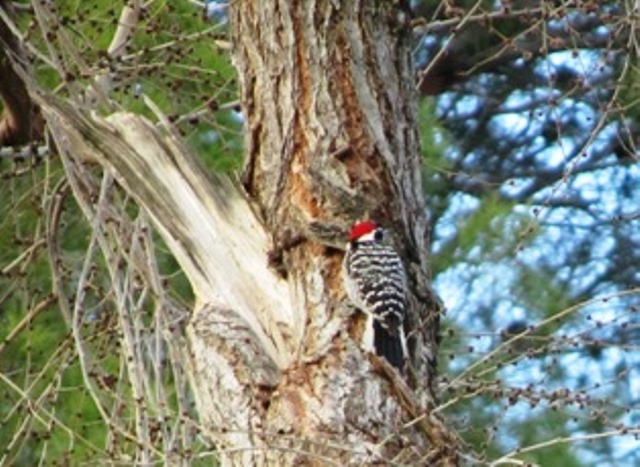
The Nuttall’s Woodpecker appears as a dash of brilliant red with black-and-white stripes wherever it perches
There are hawks doing fly-overs and blue jays flitting from the bushes to the trees.
But I especially love the little wild bird we call Crew Cut, a black phoebe that is building a nest in one of my apricot trees. And today, I spotted a Western bluebird on the fence at the front of our property.
This time of year when there is little for birds to forage on, I believe in providing bird seed, suet cakes, sunflower seeds, and peanuts for our feathered friends. I love to see them at the feeders and hope they’ll stay around to build nests in the spring.
Speaking of Roses
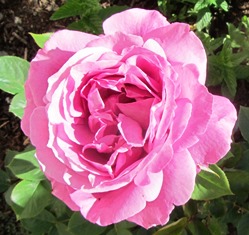
This candy-stripe rose was a gift from a friend–a cutting from her rose that became a large bush in my garden
If you love roses like I do, you probably already have a few growing in your garden. Perhaps you also look forward during long winter evenings to perusing the offerings in the catalogs of rose growers and dreaming of new varieties to plant in the spring.
Whether you are new to growing roses or have been gardening with them for a while, a review of types and species might be in order, especially before you plan a visit to your local gardening center. Bare root roses will start arriving in about three weeks here in Northern California.
TYPES OF ROSES
Roses fall roughly into four general categories: Bush Roses (this is the largest group and includes hybrid tea, polyantha, floribunda, heritage or old rose, miniature, and tree roses), Climbing Roses (large-flowering climbers have canes to 10 feet, ramblers have canes to 20+ feet and small flowers in early summer), Shrub Roses (upright growth habit reaches 4 to 12 feet and may only bloom once during summer), Groundcover Roses (also called carpet roses, these grown in low mounds and can bloom only once or repeatedly).
SPECIES of ROSES
Alba–These beauties are white or palest pink with gray-green foliage.
Bourbon–Repeat bloomers that have a wide height range and glossy green foliage.
Centifolia–These stunning beauties were favored by the Dutch master painters. Centifolia roses contain many petals on cold-hardy plants that grow 4 to 8 feet tall.
Climbers–These roses come in a wide variety of bloom type and color and have long, arching canes.
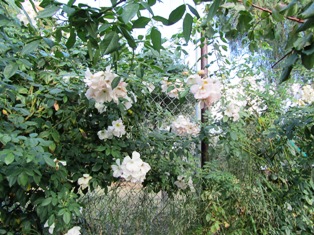
Climbing Sally Holmes produces large sprays of white to palest pink roses along the back fence of our property, from early spring to frost
Damask–May bloom only once although some varieties will repeat; the flowers are white or soft pink and fragrant. For centuries, this was the rose species used to produce Attar of Roses.
Florabunda–Produces sprays of roses and is a repeat bloomer.
Grandiflora–Similar to hybrid tea roses, the grandiflora blooms on long canes and is associated with the high-centered blooms so often seen in floral shops.
Hybrid Gallica–An old rose that blooms in the spring; flowers are pink or red or even striped and emerge on plants that stand about 4 feet tall.
Hybrid Perpetual–These roses were especially loved in the 1800’s for their red and pink color, repeat flowering, and height of six feet.
Hybrid Tea–Blooms on long canes as a single bloom or sprays of flowers.
Polyantha–Smaller blooms than the florabundas but can produce large sprays in repeated flowering.
Noisette–Plants tend to be large and often sprawl but can produce fragrant clusters of blooms and are repeat-flowering. They are sensitive to cold and frost.
Miniature–Small roses ranging in height from 1 to 3 feet with miniature flowers and foliage.
Shrub–Hybrid rugosas are an example of the shrub varieties (of which there are many). Often these roses have lots of prickles.
Tea Roses–These plants have quite large blooms, but the drawbacks include weak canes and a susceptibility to frost and cold. Their height and bloom color can vary widely.
Urban Farms Make Sense for Lots of Reasons
Reduce city blight. Give city residents the opportunity to farm. Grow food for low-rent residents. Eliminate illegal dumping. Create public gardens on private land until the owner decides on another use. Lower property taxes for land owners. Improve the local environment. These are just a few reasons urban farms make a lot of sense and should be promoted.
As it turns out, the city of San Francisco is leading the way. The city has a new law offering financial incentives in the form of reduced property taxes for owners of empty lots who permit agricultural use of their land for at least five years or more.
Part of the statewide Urban Agriculture Incentive Zones Act, the law encourages potential urban farmers to convert weedy, empty lots or those covered in trash into gardens. These urban farmers necessarily would have to put in resources such as labor and money but the law ensures they cannot be forced out of their contracts, thus losing their investment.
The law is the brainchild of sustainable land-use advocates and state Assemblyman Phil Ting, D-San Francisco. Cities must first pass the necessary local ordinance and San Francisco has already done that.
Urban farmers must comply with local ordinances with regard to keeping bees and farm animals. But the idea of urban gardens reducing blight (which may also be prone to illegal dumping) has wide appeal for cities eager to stabilize property values and also provide more green spaces.
While other cities in California explore the environmental benefits of urban farms (including Fresno, Los Angeles, Sacramento, San Diego, and San San Jose), San Francisco leads the way.
A city lot must meet certain qualifications: it has to be at least one-tenth of an acre. Additionally, there must be no permanent buildings on the lot. Qualified lots are re-assessed with a significantly lower tax bill for its owner.The new tax assessment is based on the average rate of irrigated farmland.
The idea of more urban farms means a win for the city, local residents, the land owners, and the environment.
Spate of Warm Weather Brings Out Early Blosssoms
While schools across the nation are taking snow days because of frigid temperatures, the fruit trees on my Bay Area farmette are showing signs of bud swelling and early blossoming because of a winter heat wave.
Cities around the San Francisco Bay are experiencing early January temperatures of 70-plus degrees Fahrenheit, breaking weather records in some areas. Mother Nature certainly behaves strangely at times.
My five-variety apple tree and the early Desert Gold peach trees are covered with buds that are already showing color. I haven’t as yet gotten around to the winter pruning and spraying with organic oil. Maybe if there’s no wind today, I’ll squeeze that chore in with the others.
I did cut back the Washington navel orange that is infected with Leaf Miner, a pest that’s crossed the United States from Florida. It attacks new leaves, so I’m thinking if I prune and spray now before spring is in full swing, maybe I won’t lose this tree. Curiously, the pest hasn’t widely infected my blood orange trees but there are signs of it in the leaves of our Satsuma seedless tangerines.
Elsewhere, I’ve done deep digging in the chicken run and added some wood chips and leaf material for compost.
The tea roses have been pruned back to 12 to 18 inches and old canes removed. I’m torn between wanting to add more roses in the beds in front of the bamboo plants on the east/west axis of our property or adding more lavender and sunflowers, favored by the bees.
Tomorrow, I’ll open and inspect my bee hives. I left honey stores this past autumn instead of harvesting. But if the bees have gone through all the honey, then I’ll have to add bee food until we get the first early bulb blooms and wildflowers. The French perfume lavender that the bees love is about the only bloom (bee food) in the garden now. Luckily, I planted a lot of it.
The farm chores don’t just seem endless, they are. But whether the work is daily, weekly, or seasonal, there’s something deeply rewarding–even magical–about living close to the earth in harmony with cycles of seasons and the rhythms of nature. But I admit, it is a little strange to have such warm weather when winter has only just started.
 Facebook
Facebook Goodreads
Goodreads LinkedIn
LinkedIn Meera Lester
Meera Lester Twitter
Twitter





